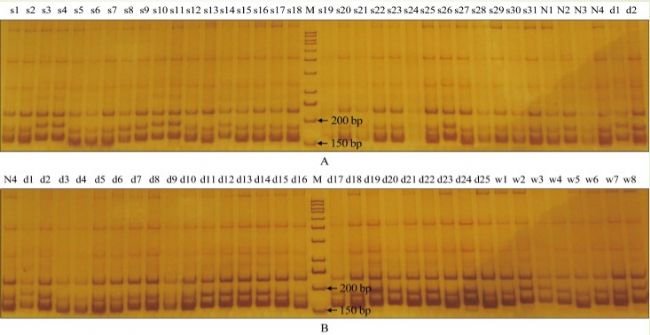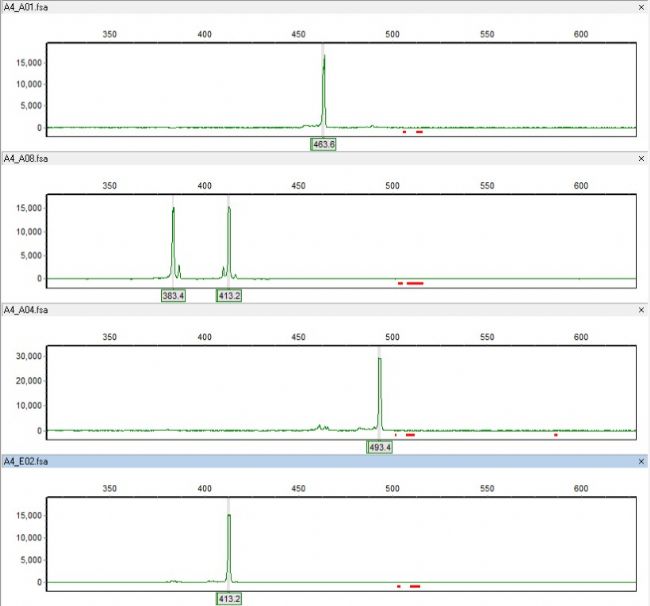Microsatellite markers (microsatellite), also known as short tandem repeats (short tandem repeats, STR), or simply repeating simple sequence repeat sequences (simple sequence repeats, SSR), are uniformly distributed in the eukaryotic genome by 2 ~ A 6-nucleotide tandem repeat fragment is constructed. Since the number of repetitions of repeating units is highly variable and abundant among individuals, the application of microsatellite markers is very extensive. Microsatellite loci are usually amplified by PCR, and the amplified products are analyzed by electrophoresis, and the alleles are separated according to size.
Due to the quantitative variation of individual microsatellite loci repeating units, the length of the individual's amplification products is polymorphic in length. This polymorphism is called simple sequence repeat length polymorphism (SSLP). Each amplification site represents a pair of alleles at this site. Since the number of SSR repeats varies widely, SSR markers can reveal much higher polymorphisms than RFLPs (restriction endonuclease fragment length polymorphisms), which is the principle of SSR markers.


Technical characteristics
(1) abundant, covering the entire genome, revealing high polymorphism;
(2) It has the characteristics of multiple alleles and provides a high amount of information;
(3) Inherited by Mendelian method, co-dominant (if the trait of both parents is expressed on the F1 individual, that is, the genetic phenomenon expressed by the two members of the pair of alleles in the hybrid is called codominance ), homozygotes and heterozygotes can be identified;
(4) The experiment has good repeatability and the result is reliable. Each locus is determined by the designed primer sequence, allowing different laboratories to interact and develop primers.

Application range
- Genetic cross breeding
- Draw a chromosome genetic map
- DNA fingerprinting and cultivar identification
- Germplasm conservation and utilization
- Genomic association analysis
Classic Case
Case number one
Title: SSR linkage map construction and QTL identification for plant height and ear height in Maize (corn SSR linkage map construction and plant height and ear height QTL mapping)
Main technology: SSR classification
Technical process:

Abstract: A linkage map was constructed using the F2 population of maize inbred line combination R15×掖478, and the plant height and ear height of 229 F2:4 families in maize were investigated by a 1-year randomized block design. . A total of 146 SSR marker loci were fitted to the linkage map, covering the genome of 1666 cM, and the average distance between markers was 11.4 cM. QTL analysis was performed by composite interval mapping method. A total of 8 QTLs controlling plant height were detected, which were located on chromosomes 2, 3, 4.5 and 8 respectively. Three QTL sites controlling the height of spikes were located on chromosome 4. . The contribution rate of QTL for individual plant height was 6.67%-11.59%, and the contribution rate of QTL for single ear height was 10.46%-12.15%.
Case 2
Title: Seed Purity Identification of a New Cucumber Variety Jinyou 35 Using SSR Technique
Main technology: SSR classification
Technical process:

Abstract: The specific molecular markers of cucumber variety Jinyou 35 were screened by using the technology system of cucumber seed purity identification established and optimized by Tianjin Kerun Company. More than 80 pairs of SSR primers were used in the experiment. Two pairs of primers (85 and 212) showed polymorphism between the hybrids and the parents. The hybrid bands were complementary to the parents and had strong specificity. Kind of purity identification. 50 pairs of seeds of Jinyou 35 were identified by SSR using these two pairs of primers. The results showed that the results of the two pairs of primers were the same, and the coincidence rate with the field identification results was as high as 96%, indicating that the two SSR markers could be used as the specific molecular markers of Jinyou 35 for the identification of seed purity.
Greenhouse Movable Irrigation System offer uniformity and flexibility in irrigation, while reducing water and labor costs. Available with multiple nozzles, allowing watering and misting options, irrigation booms are adaptable to any crop. Depending on the boom selected, multiple zones can be irrigated with one boom, allowing the grower to effectively grow multiple crops in one house. All booms can be controlled independently or through computerized controls.
Greenhouse Movable Irrigation,Greenhouse Irrigation,Greenhouse Movable Watering,Greenhouse Sprinkler System
JIANGSU SKYPLAN GREENHOUSE TECHNOLOGY CO.,LTD , https://www.alibabagreenhouse.com